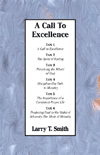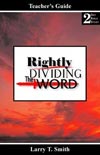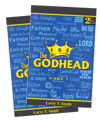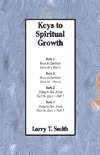















 HOME HOME BIBLE
STUDIES
BIBLE
STUDIES ONLINE
MEDIA
ONLINE
MEDIA BOOKSTORE
BOOKSTORE MISSION
MISSION CONTACT
US CONTACT
US LINKS
LINKS |
PROPER HERMENEUTICS AND THE FOLLY OF THE
"TWO CONVERSATION" ARGUMENT - Part 5
Studying Grammar and the Contextual Flow of The Olivet Discourse to Disprove the Doctrine of Dispensationalism Michael F. Blume © 2010 Michael F. Blume All
Rights Reserved 
When one reads the synoptic gospels
Matthew, Mark and Luke, one immediately understands why they are called
“synoptic”. The term “synoptic” is defined as
follows: Affording a general view of the whole,
or of the principal parts of a thing; as a synoptic table. This especially becomes pertinent when we
consider the Olivet Discourse as related in these three gospels. Since
the Synoptic Gospels afford us with a general view of the whole of
Jesus’ ministry – showing the principle parts – the
comparison of all three Olivet Discourse accounts is meant to show us a
general view of the one single discourse. When the three Gospels each
recount the same story, there is a variance of terms used. No one
suggests there are more than one event simply due to the variation of
terms.
Take for example the lists of the apostles found in the gospels. “We have four lists of the apostles, one by each of the synoptic evangelists (Mat_10:2-4; Mar_3:16; Luke_6:14), and one in the Acts (Act_1:13). No two of these lists, however, perfectly coincide.” (M.G. Easton M.A., D.D., Illustrated Bible Dictionary, 1897.) No one would consider suggesting that the four variations of the lists of apostles’ names suggest there were four different groups of apostles, as futurists claim the Olivet Discourse accounts have differences that indicate two distinct conversations. Easton also wrote,“The authors of the first three Gospels, the synoptics, wrote independently of each other. Each wrote his independent narrative under the guidance of the Holy Spirit. Each writer has some things, both in matter and style, peculiar to himself, yet all the three have much in common.” Therefore, we can say that the variation of terms used in the three accounts by the three writers of the same Olivet Discourse is only indication of the writers’ respective styles and manners peculiar to themselves. Easton quotes another source and says, “Out of a total of 1151 verses, Luke has 389 in common with Matthew and Mark, 176 in common with Matthew alone, 41 in common with Mark alone, leaving 544 peculiar to himself. In many instances all three use identical language.” (Cambridge Bible, Luke, Introd.) Comparing each synoptic gospel to the other, Easton noted, “thirteen-fourteenths of Mark, four-sevenths of Matthew, and two-fifths of Luke are taken up in describing the same things in very similar language.” I claim that among the 13/14 of Mark, the 4/7 of Matthew and the 2/5 of Luke that are describing the same things includes the Olivet Discourse of Matt 24, Mark 13 and Luke 21. Andrew Robert Fausset wrote these words, “In 42 sections the three Synoptists coincide; 12 more sections are given by Matthew and Mark alone; five sections are given by Mark and Luke alone, 14 sections are given by Matthew and Luke. Besides, five sections are unique to Matthew, two sections are unique to Mark, and nine sections are unique to Luke. The verbal coincidences are chiefly in reciting the words of Jesus or of others in connection with, Him, seldom in the narrative of the evangelists themselves. In Matthew the proportion is as one to more than two, in Mark one to four, in Luke one to ten (Norton, Genuineness, I. 240).” (Fausset's Bible Dictionary by Andrew Robert Fausset (1821-1910), co-Author of Jamieson, Fausset and Brown's COMMENTARY ON THE WHOLE BIBLE.) Much ado is made by some dispensationalists about a discrepancy between the three gospel accounts regarding the sign Jesus gave for the Christians to flee Jerusalem. A.T. Robertson made this remark, “Christians did flee from Jerusalem to Pella before it was too late as directed in Luke_21:21; Mar_13:14.; Mat_24:16.”Notice he indicated that the three accounts all were fulfilled by Christians fleeing to Pella, thereby implying the signs were actually one and the same, and referred to first century fulfillments in all three cases. (WORD PICTURES IN THE NEW TESTAMENT, by Archibald Thomas Robertson. Comment on Luke 21:20). B.W. Johnson wrote, “In the holy place. Mark says, ‘Where it ought not;’ around ‘the holy city.’” (The People's New Testament (1891) by B. W. Johnson, comment on Matthew 24:15). This informs the reader that the armies “around the holy city” fulfilled this prophecy. Johnson had no trouble with the inside/outside conundrum that some dispensationalists feel exists if one were to state that the SIGN to flee was one and the same. Dispensationalists have claimed that Matthew’s and Mark’s references to the abomination of desolation being the sign for believers to flee cannot be one and the same sign as what Luke described in speaking of Jerusalem surrounded by armies. They claim Matthew and Mark speak of the abomination of desolation as occurring in the temple alone, and that conflicts with the sign of armies surrounding Jerusalem. How can this be one and the same conversation, they say, if Matthew and Mark speaks of a sign inside the city in the temple, and Luke speaks of a sign outside the city and around it? Johnson also said, “Mat 24:15-20 When therefore ye see the abomination of desolation. This is the sign when Christians should flee from Jerusalem. See Dan_9:27; Dan_11:31; Dan_12:11. Luke says, ‘When ye shall see Jerusalem compassed with armies’ (Luke_21:20). [color]This was, therefore, Christ's explanation of the abomination of desolation.[/color]” According to Johnson, Luke’s account explained what the abomination of desolation was! He implied Matthew and Mark merely mentioned the abomination, but Luke actually explained the details of what it was! Luke’s Gospel was without a doubt written to Gentile readers, and Luke was a well known companion of Paul the apostle to the Gentiles. Scholars agree Luke went into details that common Jews would know as a given, in order for the Gentile readers to more clearly get the point. Jamieson, Fausset and Brown wrote, “ But the explanations in his Gospel of things known to every Jew, and which could only be intended for Gentile readers, make this quite plain - see Luke_1:26; Luke_4:31; Luke_8:26; Luke_21:37; Luke_22:1; Luke_24:13. A number of other minute particulars, both of things inserted and of things omitted, confirm the conclusion that it was Gentiles whom this Evangelist had in the first instance in view. "…But we have also observed that along with this he shows a wonderful flexibility of style, so much so, that when he comes to relate transactions wholly Jewish, where the speakers and actors and incidents are all Jewish, he writes in such Jewish Greek as one would do who had never been out of Palestine or mixed with any but Jews.” This would explain why Luke’s reference to the armies around Jerusalem was written instead of simply speaking of the abomination of desolation that Mark and Matthew wrote about. Jews would readily know that it was abomination for the Romans to stand around Jerusalem with idols whereas Gentiles might not, as I feel is precisely the case with the dispensationalists’ aversion to the abomination being those armies on city grounds. Adam Clarke agreed with Johnson: “ Mat 24:15 The abomination of desolation, spoken of by Daniel – This abomination of desolation, St. Luke, (Luke_21:20,Luke_21:21), refers to the Roman army; and this abomination standing in the holy place is the Roman army besieging Jerusalem; this, our Lord says, is what was spoken of by Daniel the prophet, in the ninth and eleventh chapters of his prophecy; and so let every one who reads these prophecies understand them; and in reference to this very event they are understood by the rabbins. The Roman army is called an abomination, for its ensigns and images, which were so to the Jews. Josephus says, (War, b. vi. chap. 6), the Romans brought their ensigns into the temple, and placed them over against the eastern gate, and sacrificed to them there. The Roman army is therefore fitly called the abomination, and the abomination which maketh desolate, as it was to desolate and lay waste Jerusalem; and this army besieging Jerusalem is called by St. Mark, Mar_13:14, standing where it ought not, that is, as in the text here, the holy place; as not only the city, but a considerable compass of ground about it, was deemed holy, and consequently no profane persons should stand on it.” BACK | NEXT RDTW
|
|
© Copyright 2010 Rightly Dividing the Word - All Rights Reserved Please assume that all materials on this website are copyrighted by Rightly Dividing the Word. For permission and details see our terms and conditions. For problems with this website, please contact webmaster1@rightlydividingtheword.com. |






